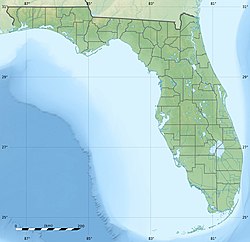| Patrick Space Force Base | |||||||||
|---|---|---|---|---|---|---|---|---|---|
| Near Cocoa Beach, Florida in the United States | |||||||||
 HC-130 Hercules of the 920th Rescue Wing based at Patrick SFB | |||||||||
 Emblem of Space Launch Delta 45 | |||||||||
| Site information | |||||||||
| Type | US Space Force Base | ||||||||
| Owner | Department of Defense | ||||||||
| Operator | United States Space Force | ||||||||
| Controlled by | Space Launch Delta 45 | ||||||||
| Condition | Operational | ||||||||
| Website | www | ||||||||
| Location | |||||||||
| Coordinates | 28°14′06″N80°36′36″W / 28.23500°N 80.61000°W | ||||||||
| Site history | |||||||||
| Built | 1940 (as Naval Air Station Banana River) | ||||||||
| In use |
| ||||||||
| Garrison information | |||||||||
| Current commander | Maj Gen Stephen G. Purdy, Jr. | ||||||||
| Garrison | Space Launch Delta 45 (host wing) | ||||||||
| Airfield information | |||||||||
| Identifiers | IATA: COF, ICAO: KCOF, FAA LID: COF, WMO: 747950 | ||||||||
| Elevation | 2.4 metres (7 ft 10 in) AMSL | ||||||||
| |||||||||
| Source: Federal Aviation Administration [1] | |||||||||
Patrick Space Force Base( IATA : COF, ICAO : KCOF, FAA LID : COF) is a United States Space Force installation located between Satellite Beach and Cocoa Beach, in Brevard County, Florida, United States. It is named in honor of Major General Mason Patrick, USAAC. It is home to Space Launch Delta 45 (SLD 45), known as the 45th Space Wing (45 SW) when it was part of the Air Force. In addition to its "host wing" responsibilities at Patrick SFB, the 45 SW controls and operates Cape Canaveral Space Force Station (CCSFS) and the Eastern Range.
Contents
- History
- Naval use in World War II
- Use under the United States Air Force
- Use under the United States Space Force
- Operational history
- Aerospace Defense Command use
- Strategic Air Command use
- Major commands / field commands assigned
- Major units assigned
- Role and operations
- 45th Space Wing
- Air Force Technical Applications Center
- 920th Rescue Wing
- U.S. State Department
- Based units
- United States Space Force
- United States Air Force
- United States Department of State
- Infrastructure and facilities
- Buildings
- Access
- Water
- Media
- Amateur radio restrictions
- See also
- References
- Other sources
- External links
The base was originally opened and operated from 1940 to 1947 as Naval Air Station Banana River, a United States Navy airfield. It was then deactivated as a naval installation in 1947 and placed in caretaker status until it was transferred to the United States Air Force in late 1948. After briefly taking on the name Joint Long Range Proving Ground, the base was known as the Patrick Air Force Base beginning in 1950. The base took on its current name in 2020 upon its transfer to the recently established U.S. Space Force.
Additional tenant activities at Patrick SFB include the 920th Rescue Wing, the Air Force Technical Applications Center, and the Defense Equal Opportunity Management Institute (DEOMI). Total employment is 10,400. There are 13,099 military, dependents, civilian employees, and contractors on base. [2]
The base is a census-designated place (CDP) and had a resident population of 1,642 as of the 2020 census, up from 1,222 at the 2010 census. [3] It is part of the Palm Bay—Melbourne—Titusville, Florida Metropolitan Statistical Area.
The base also administers the Malabar Annex in Palm Bay.














